SOLIDWORKS: Modeling Fluidity
Modeling Fluidity
SOLIDWORKS has a great reputation for responding to their customers’ needs as well as responding through continuous improvement of their product. From its inception, SOLIDWORKS has provided many user friendly tools (i.e. toolbars, keyboard shortcuts, in context pop-ups, and the “S” key to name a few). In more recent years, SOLIDWORKS has dedicated specialized resources with the specific purpose of improving the efficiency of the user interface and streamlining work flow. The most recent and powerful of these include; mouse gestures, the ability to customize the “S” key, and user customization of the in context pop-up.
These great tools can save enormous amounts of time if the designer is working with solid modeling, but may become busy or even cumbersome if the designer wants to flow from solid modeling to surface modeling, then sheet metal or structural design. Currently the best method to provide the customization required for this flexibility is contained within the “Copy Settings Wizard”.
The “Copy Settings Wizard” was first introduced as a way to save or restore system settings and file locations when moving the application from one computer to another or to standardize multiple client installations. Up until 2013, this tool could only be used when the SOLIDWORKS application was shut down and had limited flexibility regarding what was saved or restored. Currently the “Copy Settings Wizard” can be executed while SOLIDWORKS is running and specific items such as, System Options, Toolbar layout, etc. may be added or omitted when saving or restoring items.
Here is a step by step guide to making the “Copy Settings Wizard” into a valuable tool for modeling fluidity:
Create any customization of the Toolbar layout, “Mouse gestures”, Keyboard shortcuts, or the context sensitive shortcut bar (“S”) key that will facilitate a more efficient use of the items available near the mouse pointer.
For example, the “S” key for solid modeling might look like this:

And for surface modeling, like this:

Once all of the customizations are complete, close all SOLIDWORKS files and start the “Copy Settings Wizard” from the “Options” drop down:

or from the Task Manager

The “Copy Settings Wizard” will open with its own window.
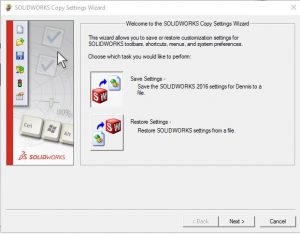
Select the “Save Settings” and click “Next”.
NOTE: Do not select the “System options” check box (this will allow sharing of these setting on other computers).
Click “Finish” and this message will appear:
Now with the customization saved, moving from one modeling function to another can be accomplished quickly using the reverse procedure. When modeling using the solid techniques and features, close all files.
Open the “Copy Settings Wizard”
Select “Restore Settings” and Click “Next”.
Browse to the “.sldreg” file to be restored and Click “Next”.

Clear the option to create a backup and click “Finish”.

If this message appears, click “Yes”.
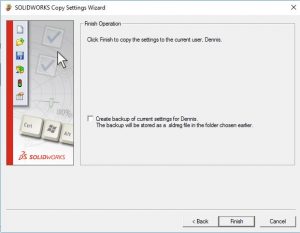
Then this message will appear.

By adding this new method of using the “Copy Setting Wizard”
to all of the other efficiencies available to designers, moving in and out of
the multiple modeling techniques make better use of the power of 3D modeling with SOLIDWORKS.
Dennis Barnes
Application Engineer
Computer Aided Technology

 Blog
Blog